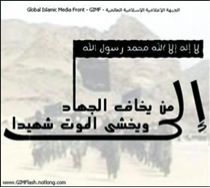
In this image, the unmistakable black banner with the testament of faith (shahada) is hoisted on a mast that is fashioned out of the letter “alif” in the Arabic word “jihad” in the slogan. This makes a clear physical connection between demonstrating one’s faith in both verbal declaration as well as in deed, i.e., in carrying out the jihad. The caption reads: “la ilaha illa Allah, Muhammad rasul Allah; ila man yakhafu al-jihad wa-yakhsah al-mawt shahidan” (“there is no god but Allah and Muhammad his messenger; to he who fears jihad and is scared of dying a shahid [martyr]”). Images of mountains, as seen in the background of this image, are a common motif in jihadi visual propaganda, and occasionally allude to regions with past or ongoing operations, such as Afghanistan, Chechnya and Kashmir. More generally, however, mountains are included in an image to evoke divine omnipotence, eternity and grandeur, and, in combination with other elements, mountains can suggest sacrifice and martyrdom.
The black banner/color in the image carries special meaning. According to hadiths (prophetic traditions or reports), the black banner was the battle flag of the Prophet Muhammad, and was carried into battle by many of his companions. The image of the black flag has been used as a symbol of religious revolt and engagement in battle (i.e., jihad). In the contemporary Islamist movement, the black flag is used to evoke notions of jihad and of reestablishing the Islamic Caliphate. The idea of an “unknown journey” is heightened by the image of marching warriors in the background. They are depicted as journeying on the right path, the path of jihad, and the righteousness of their journey is implied by the juxtaposition of the slogan: “to those who fear jihad and dying as a martyr.” Thus, the slogan is both a call to join the jihad and a sarcastic rebuke against those who have failed to heed the call.
 Skip to content
Skip to content
